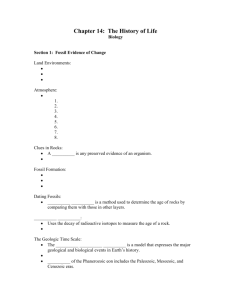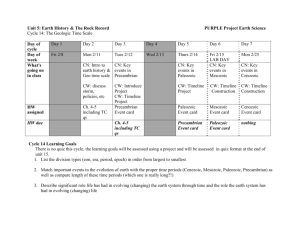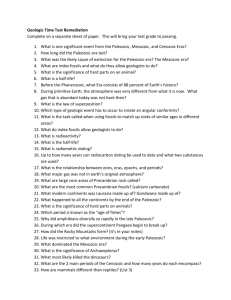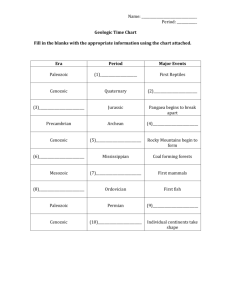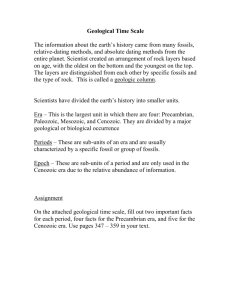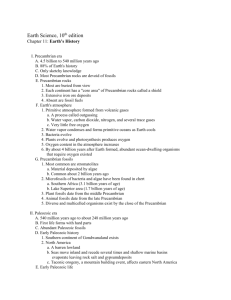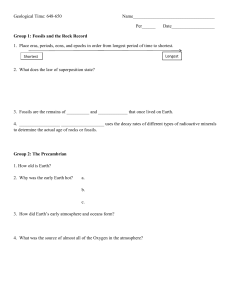to Ch. 13 Notes
advertisement
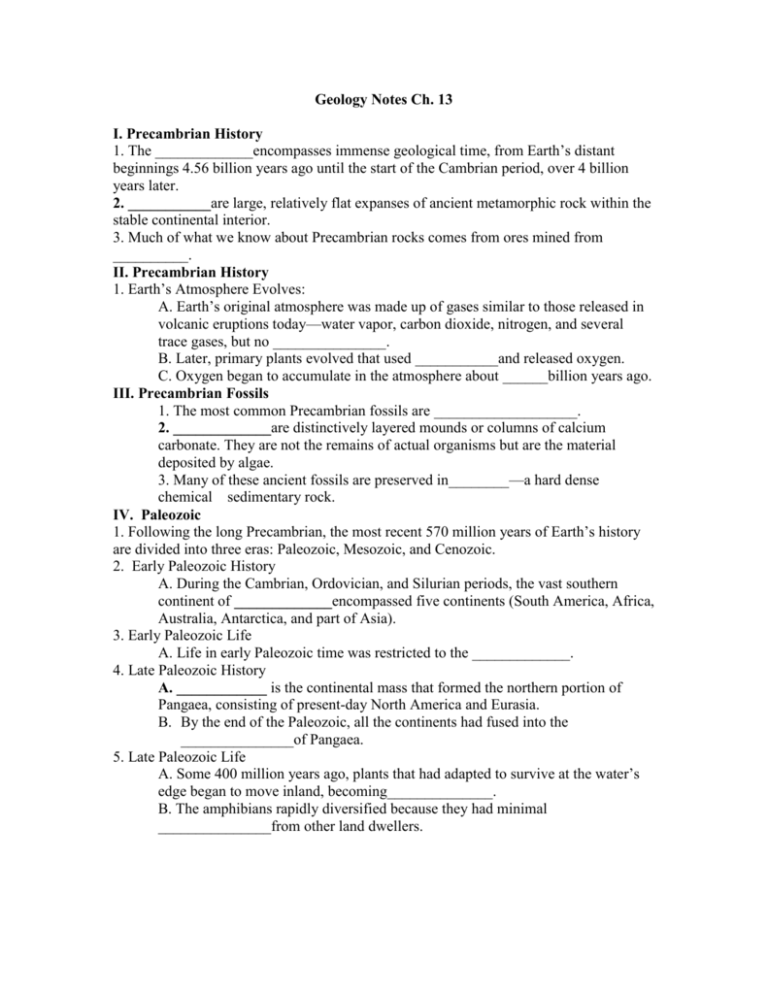
Geology Notes Ch. 13 I. Precambrian History 1. The _____________encompasses immense geological time, from Earth’s distant beginnings 4.56 billion years ago until the start of the Cambrian period, over 4 billion years later. 2. ___________are large, relatively flat expanses of ancient metamorphic rock within the stable continental interior. 3. Much of what we know about Precambrian rocks comes from ores mined from __________. II. Precambrian History 1. Earth’s Atmosphere Evolves: A. Earth’s original atmosphere was made up of gases similar to those released in volcanic eruptions today—water vapor, carbon dioxide, nitrogen, and several trace gases, but no _______________. B. Later, primary plants evolved that used ___________and released oxygen. C. Oxygen began to accumulate in the atmosphere about ______billion years ago. III. Precambrian Fossils 1. The most common Precambrian fossils are ___________________. 2. _____________are distinctively layered mounds or columns of calcium carbonate. They are not the remains of actual organisms but are the material deposited by algae. 3. Many of these ancient fossils are preserved in________—a hard dense chemical sedimentary rock. IV. Paleozoic 1. Following the long Precambrian, the most recent 570 million years of Earth’s history are divided into three eras: Paleozoic, Mesozoic, and Cenozoic. 2. Early Paleozoic History A. During the Cambrian, Ordovician, and Silurian periods, the vast southern continent of _____________encompassed five continents (South America, Africa, Australia, Antarctica, and part of Asia). 3. Early Paleozoic Life A. Life in early Paleozoic time was restricted to the _____________. 4. Late Paleozoic History A. ____________ is the continental mass that formed the northern portion of Pangaea, consisting of present-day North America and Eurasia. B. By the end of the Paleozoic, all the continents had fused into the _______________of Pangaea. 5. Late Paleozoic Life A. Some 400 million years ago, plants that had adapted to survive at the water’s edge began to move inland, becoming______________. B. The amphibians rapidly diversified because they had minimal _______________from other land dwellers. 6. The Great Paleozoic Extinction A. The world’s climate became very seasonal, probably causing the dramatic __________of many species. B. The late Paleozoic extinction was the greatest of at least _____mass extinctions to occur over the past 500 million years. V. Mesozoic Era 1. ____________were land-dwelling reptiles that thrived during the Mesozoic era. 2. Mesozoic History A. A major event of the Mesozoic era was the _________of Pangaea. 3. Mesozoic Life A. _____________are seed-bearing plants that do not depend on free-standing water for fertilization. B. The gymnosperms quickly became the dominant plants of the Mesozoic era. 4. The Shelled Egg A. The ____________of a water-dwelling stage (like the tadpole stage in frog) was an important evolutionary step. 5. Reptiles Dominate A. With the perfection of the shelled egg, _______quickly became the dominant land animals. B. At the end of the Mesozoic era, many reptile groups became extinct. VI. Cenozoic North America 1. The Cenozoic era is divided into two periods of very unequal duration, the __________period and the Quaternary period. 2. Plate interactions during the Cenozoic era caused many events of mountain building, volcanism, and earthquakes in the West. 3. Cenozoic Life A.____________—animals that bear live young and maintain a steady body temperature— replaced reptiles as the dominant land animals in the Cenozoic era. B.____________—flowering plants with covered seeds—replaced gymnosperms as the dominant land plants. C. Mammals Replace Reptiles: Adaptations like being______________, developing insulating body hair, and having more efficient heart and lungs allow mammals to lead more active lives than reptiles. D. Large Mammals and Extinction In North America, the mastodon and mammoth, both huge relatives of the elephant, became extinct. In addition, saber-toothed cats, giant beavers, large ground sloths, horses, camels, giant bison, and others died out on the North American continent. E. The reason for this recent wave of extinctions puzzles scientists.

